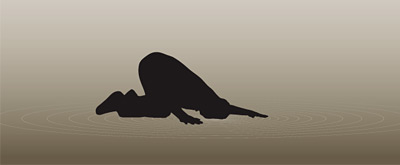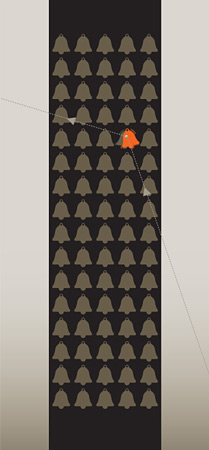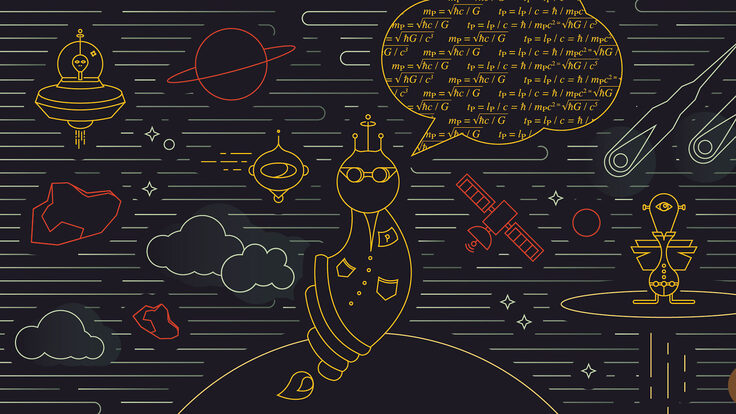Listening for whispers of dark matter
by D.A. Venton
 |
| Illustrations: Sandbox Studio |
Jodi Cooley works half a mile underground, in a mine that stopped operating 40 years ago. A rattling elevator takes her to work, 27 floors beneath the surface. The ride down the mineshaft is five minutes of complete darkness. A colony of bats inhabits the mine.
"For someone who's squeamish," says Cooley, "it's not the best work environment." When she is on shift she spends 10 hours a day in the mine, 10 days in a row. Looking to find a new type of particle, Cooley is listening for whispers of dark matter.
The underground experiment she works on, a collaboration of 60 physicists and engineers, is the world's most sensitive search for a type of particle that, as of yet, has only been theorized. The Cryogenic Dark Matter Search (CDMS) uses detectors chilled nearly to the lowest possible temperature, minus 273 degrees Celsius, to "listen" for vibrations caused by these particles streaming in from space. The discovery of these particles would revolutionize our view of the cosmos.
For Cooley, a postdoc at Stanford University, a day at the Soudan Underground Laboratory in Minnesota begins with a cup of coffee. After a telephone meeting with Dan Bauer, who leads the CDMS operations, she and her shift partner spend the rest of the day monitoring the experiment's cooling system, detectors, and electronics. Cooley, speaking from the mine by telephone, says she never suffers from boredom. "Even when things are going smoothly, down here we can always find more work to do," she says. "There is no lack of work to be done."
Mysterious dark matter
Astronomical observations made in the last ten years tell us that much of the universe is held together by a form of matter we can not see—dark matter. In particular, researchers have found that galaxies rotate faster than they should if luminous matter—the matter contained in stars—is the only matter holding a galaxy together. Luminous matter (what we think of as "ordinary" matter) makes up less than one fifth of the total mass in the universe. The remainder is the mysterious dark matter.
If dark matter holds luminous matter together in galaxies, then galaxies must be areas where dark matter has aggregated. We, residents of the Milky Way galaxy, possibly are floating through a cloud of dark matter, right at this moment. But what is the stuff made of?
Scientists don't know yet whether dark matter is composed of one type of particle or various different particles. Theorists have proposed several candidates for dark matter particles. So far, dark matter's interaction with gravity is our only certain clue to its existence. Fortunately, this gives experimenters a starting point.
Given the mystery surrounding dark matter, the experimental concept—detecting its interactions with normal matter—is surprisingly straightforward. If dark matter can pull gravitationally, it has mass. A particle with mass can potentially hit an ordinary matter particle, such as the nucleus of an atom. The impact of this collision causes the nucleus to recoil—it is pushed out of place and rebounds back.
Vibrations from this recoil provide a tiny, quiet motion—the signal for direct detection experiments such as CDMS. The greatest challenge is to sift out signals created by ordinary matter particles, such as the ones created by radioactive decays and by cosmic rays hitting Earth—signals that CDMS researchers classify as background.
The setup of the CDMS experiment provides an edge over other experiments.
"The CDMS detectors are the best at discriminating against background signals," says Bauer, project manager for the experiment. "Before we announce a discovery, the world will demand a high degree of certainty that we are detecting dark matter, not some background."
A quiet place for listening
The half-mile of rock above the Soudan lab protects the experiment's detectors by absorbing most of the cosmic-ray radiation. Lead shielding, recovered from a ship that sunk off the coast of France two centuries ago, shields the detectors from radiation generated by radioactive decay in the surrounding rock. While ordinary lead also makes a good shield, it contains a small amount of radioactive isotopes, which takes about one hundred years to decay to low levels. Using old lead is an additional step CDMS scientists have taken to reduce background signals.
Despite these precautions, the CDMS detectors still pick up background signals from gamma rays, electrons, and protons. Fortunately, these common particles are easy to screen out as they rip through the detector, leaving a wake of ionization. The sought-after dark matter particles would leave more subtle signatures.
 |
For scientists to "hear" a dark matter particle, it must hit an atom in one of the crystals at the heart of the CDMS detectors. The crystals are kept cold—close to absolute zero—to reduce atomic movement, keeping the crystals quiet. The detectors "listen" for vibrations inside the crystal, like ears listening for vibrations in the air.
The detectors contain two kinds of crystals, germanium and silicon. A germanium atom is larger than a silicon one: Its nucleus has 73 protons and neutrons compared to silicon's 28. This size difference helps CDMS sort out yet another source of background—neutrons. High-energy cosmic rays and radioactive decays in the matter surrounding the detectors can produce neutrons. Hitting atoms in the crystals, these neutrons cause a "sound" in the detectors similar to the one made by the predicted dark matter particles.
CDMS scientists know how to distinguish the ringing of these two bells. Neutrons interact with atomic nuclei via the strong nuclear force. Traveling through the CDMS crystals, neutrons scatter off silicon nuclei as often as they do off germanium nuclei. In contrast, the type of dark matter particle CDMS is searching for—a weakly interacting massive particle (WIMP)—is immune to the strong nuclear force. According to predictions from supersymmetric theory, WIMPs would hit the larger germanium atoms more often than the silicon ones.
In their detective work, scientists rely on yet another clue. Neutrons are likely to scatter several times, causing signals in multiple crystal detectors; in contrast, a dark matter particle probably never would.
A lone note
During its run from February to August 2004, the CDMS experiment recorded one event that was in the signal range for dark matter. "It would have been really exciting to see two or three events," says Bauer. "We calculated our background levels and weren't really surprised to see one." After looking at the event in detail, it was discarded—the detector was having problems.
"Even if we had convinced ourselves this was a dark matter event," says Bauer, "you can't go before the world with a single event and announce that you've found dark matter."
With detector problems ironed out and more detectors installed, the CDMS collaboration has begun a long run of data taking, which started in October 2006, and is set to end in three years. The most popular model of supersymmetry predicts that CDMS might see as many as seven dark matter particle events during this run. "We're waiting for that excitement here," says Bauer. "That would be enough for us to say, Yes, we've found a signal.'"
For a long time, studying dark matter explanations was "just a theorist's playground," says Scott Dodelson, head of the Fermilab Theoretical Astrophysics Department. "But now the subject is thriving with experiments."
If CDMS, or some other experiment, finds signals of dark matter, the world of physics will be electrified. "It would be fantastic," says Dodelson. "If we detect dark matter, a promising idea will be transformed into an element of reality."
The discovery of these new particles would be the beginning of a new era of research.
"We're desperately searching for physics beyond the Standard Model," says Dodelson, explaining that the basic theoretical framework does not allow for dark matter particles. "The discovery would also tell us about the nature of that next layer of physics. Does it involve supersymmetry? Extra dimensions? It would drive physics research for the next century."
The Soudan mine will be home to CDMS for only a few more years. The next phase of the experiment, SuperCDMS, will take place 1.5 miles underground in Canada's SNOLab. Located in a nickel mine in Sudbury, Ontario, SNOLab is the world's deepest operating underground laboratory. It is three times deeper than the Soudan mine, offering better shielding from cosmic rays.
The SuperCDMS installation will have detectors that are 2.5 times larger than the current experiment, providing a bigger target for dark matter particles. The installation of the experiment is set to begin in 2008, and data collection will start in 2010.
 |
| Hitting an atom inside a crystal, a dark matter particle would cause vibrations, similar to the ringing of a bell. CDMS scientists can distinguish this "sound" from the vibrations caused by other particles traversing the crystal, such as neutrons and cosmic rays. |
Many routes to discovery
CDMS's approach, referred to as direct detection, is one of three ways physicists are looking for dark matter. In indirect detection experiments, researchers use telescopes to look at the sky to spot effects caused by dark matter. Particle colliders are the third method, in which experimenters try to artificially produce dark matter. Putting the different results together will be the key to our understanding of dark matter.
Indirect searches look for the signs of annihilating dark matter particles such as gamma rays, neutrinos, and an excess of antimatter particles. These searches point telescope-detectors to areas of the universe where dark matter particles might have aggregated and be prolific enough to collide, such as the center of a galaxy or the center of the sun.
If a detector picks up gamma rays that are explainable in no other way, the signal might indicate an area with a high density of dark matter, yielding information about how dark matter is distributed. At present, scientists think dark matter aggregates in large swells, but its distribution might be clumpy.
The nature of indirect detection experiments, however, makes it hard to know whether dark matter is the true origin of the observed signals. Since our knowledge of astrophysics is incomplete, how can scientists be sure that a signal can not be explained in some other way?
Particle colliders present the only path to producing dark matter particles in a laboratory and to studying their nature in depth. Using colliders, scientists perhaps could create and analyze these particles in large quantities. Theoretical models suggest that the Tevatron particle collider at Fermilab or higher-energy machines such as the Large Hadron Collider at CERN and the proposed International Linear Collider could produce dark matter particles. The machines could allow for measuring the mass and other properties of the particles with sufficient precision so that scientists could identify the correct theory describing the particles.
At this juncture, however, direct detection experiments are crucial to maximize our chance of finding dark matter particles, and CDMS researchers might be the first to announce their discovery. Working half a mile underground, listening carefully, Bauer, Cooley, and their colleagues might hear their first whispers.
Click here to download the pdf version of this article.






